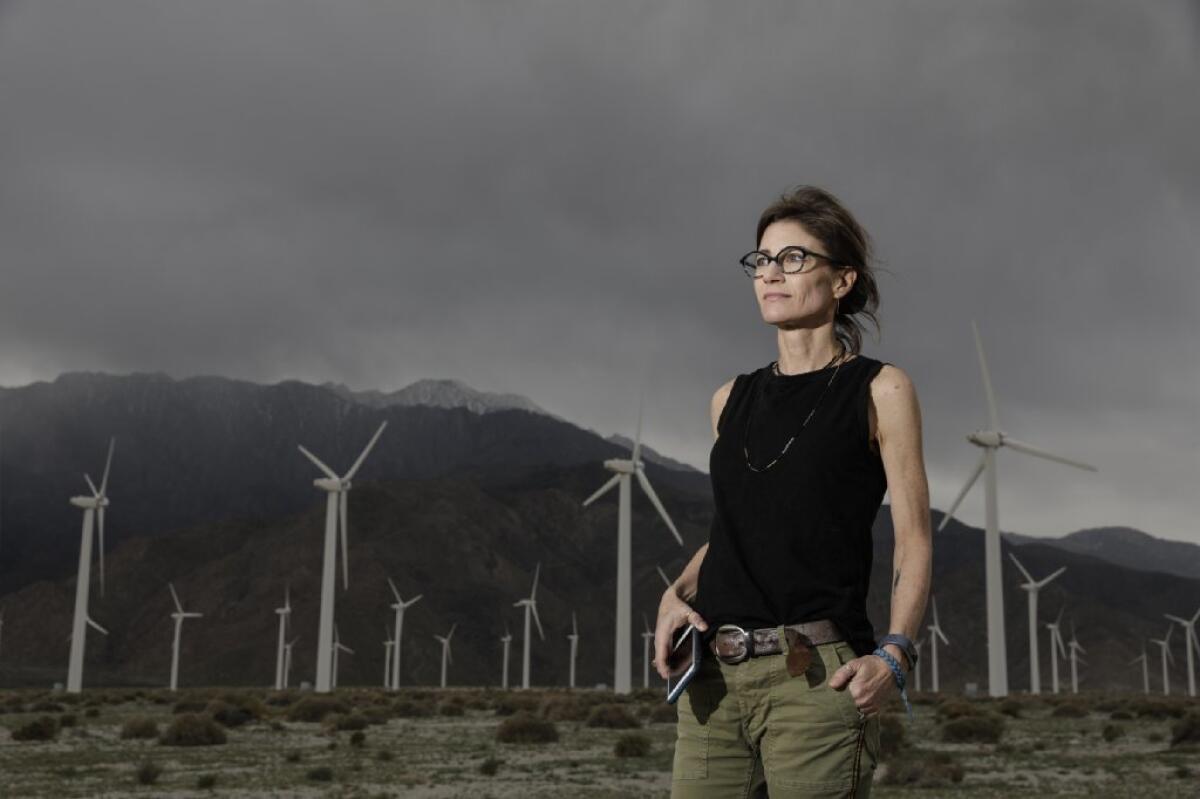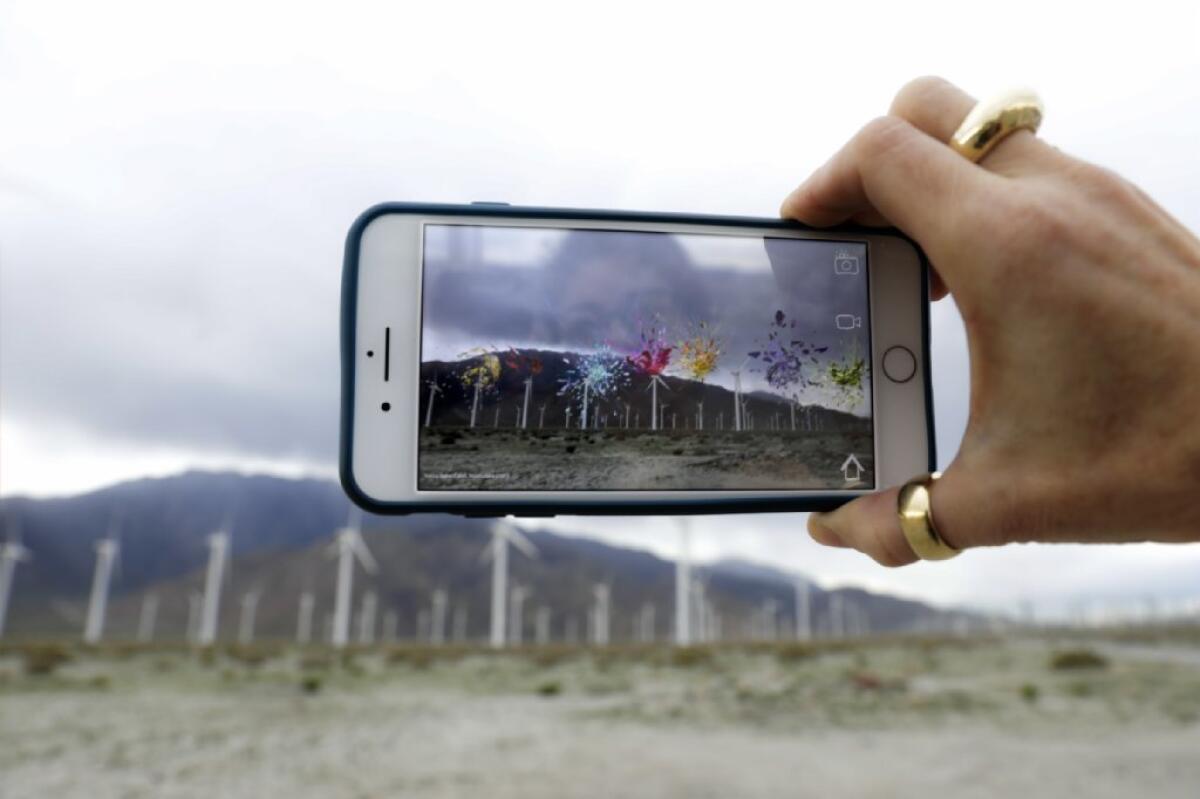With a free phone app, Nancy Baker Cahill cracks the glass ceiling in male-dominated land art

- Share via
The desert plain is dense with spinning wind turbines beneath heavy rain clouds.
Then, suddenly, the artwork appears.
Enormous desert blossoms — in fuchsia, gold and poppy orange — materialize above the windmills. They bloom until they burst, the petals flipping in the air before drifting south toward the Salton Sea.
This is Nancy Baker Cahill’s augmented-reality artwork “Revolutions” — part aerial, mechanical garden and part digitally rendered mirage. The animation is visible only through a free smartphone app that Baker Cahill created, and only when the viewer is standing in the specific location she delineates — in this case, a Palm Springs wind farm.

“It’s as if robots planted an AI garden here,” Baker Cahill says, sitting on a boulder near North Indian Canyon Drive, holding her phone in the air. Around her, the view is benignly familiar: open sky, rows of turbines and sandy, rocky ground. The view through her phone is the same — except for the exploding blossoms in the sky.
“It’s about the dissolution and disruption of flora and fauna,” she says. “When you raze the land to create a wind farm — which addresses a crisis of our own making — you end up destroying a lot of the natural ecosystem that’s there. And on sacred land. So it’s also about the shattering of living things and particulate life and death. It’s about what it will take to effect change.”
The work is one of 19 in the contemporary art biennial Desert X, which includes large-scale installations across 50 miles of the Coachella Valley. Baker Cahill has another augmented-reality work in the show. “Margin of Error” depicts a swirling, sparkling vortex of organic-looking matter — bits of what might be shell or sand, salt crystals or fish cartilage — in a whirring mass over the Salton Sea.
The two works, more than 40 miles apart, respond to their individual locations. “Margin of Error” is a nod to the coexistence of beauty and toxicity at the Salton Sea and the fragility of its ecosystem, while “Revolutions” calls attention to our demand for energy. But the pieces are also in direct dialogue with each other, addressing environmental issues, land art and technology, not to mention a woman’s place in those worlds.
Land art, or earth art, historically has been an especially male-dominated genre. During the 1960s and ’70s, when land art gained popularity, artists such as Michael Heizer, Robert Smithson, Dennis Oppenheim and James Turrell sculpted the Earth, often with heavy machinery, creating large-scale, site-specific outdoor works using boulders, soil and surrounding vegetation — all framed by the sky and lines of the horizon.
“The question posed by any contemporary land art show is, ‘What would land art look like now?’” says Desert X founding curator Neville Wakefield. “Here we have Nancy, a woman, who’s making something on a monumental scale that has no environmental impact. It’s a very kind of eloquent answer to what land art of the future might look like.”
But even futuristic land art, like all outdoor public art, is subject to weather. Baker Cahill has since moved “Revolutions.” During recent rains, North Indian Canyon Drive flooded and she was concerned about visitors’ safety. She relocated the work slightly west, to a higher site on Tipton Road, where it meets Highway 111.
“The concept remains the same, it’s just above a different wind farm,” she says.
Baker Cahill came to AR circuitously. She studied art at Williams College in Massachusetts and then worked at a Boston TV station writing descriptive narration for the blind and visually impaired. She took more than a decade off from making art while raising children in L.A. And when she returned to her art practice, the world — and tools available to her — were very different.
After first focusing on graphite drawing and gouache painting, she returned to an early love of experimental video making, pushing to create work that was more and more immersive.
In 2016 she made a series of graphite and mixed media drawings — chaotic, biomorphic forms she punctured with a leather puncher to create mathematical sequences. One of those works was hanging in her Atwater studio when a visitor stopped by and exclaimed: “Oh my God, that’s exactly how I feel!”
“It was a lightbulb moment,” Baker Cahill says. “I thought: ‘I wanna put her inside the drawing, I want to make her feel it more.’”
So Baker Cahill began experimenting with virtual reality, “the most empathic medium,” she says. She tried VR for the first time in her brother-in-law’s garage. “He had a whole rig set up for fun,” she says. “I had that rush of ‘wait a second, what if I could do this in drawing?’” So she bought the VR hardware and dove in.
The new VR technology was physically thrilling to work with, Baker Cahill says. The process involves mark-making in the air with a handheld controller and virtual reality drawing app. The images are captured by lasers and saved in a computer.
Watching Baker Cahill draw in VR, with goggles affixed to her face and hand wielding a controller, is like watching an avant garde dance performance. She crouches on the ground in her studio, a stern expression on her face, slicing the air with what looks like an elongated TV remote, her outstretched arm pointing into different corners of the room. Or she makes elaborate, sweeping arches with the controller before collapsing to the floor in a heap.
The experience, she says, is so deeply physical, it changed how she draws on paper.
“When you draw in the void, you’re kind of an architect and a sculptor,” she says. “You’re building this drawing in 360. Which causes you to think differently about mass and velocity. Now when I look at a piece of white paper, it’s like everything’s turned up to 11. I see that space as more infinite.”
While VR was “magical and amazing,” a totally immersive experience, Baker Cahill also found it exclusive: The viewer needs expensive gear. But VR drawings, she learned, could be translated into AR, an experience that meshes the viewers’ real-life surroundings with the digital art when viewed through a tablet or phone.
“I believe in access to art, and public art, and wanted to give it the broadest possible reach,” she says. “AR is a far more democratic medium, nearly everyone has a smartphone.”
With the help of app developer Drive Studios, Baker Cahill created her own AR app, “4th Wall,” which debuted in February 2018. The name has layers of subtext: At the heart of her art practice, Baker Cahill aims to “break the fourth wall,” as it’s referred to in theater, and pull the viewer as far into her work as possible. Breaking the fourth wall is also a reference to blowing up traditional boundaries and showing art outside the walls of institutions. Perhaps most simply, it speaks to the idea that, as VR and AR technology is increasingly embraced by fine artists, “anything is possible,” Baker Cahill
Once Baker Cahill discovered she could geo-locate artworks — meaning she could make them viewable only in specific locations — she got especially creative. “I wanted to use the technology subversively,” she says, “because of the moment we’re in right now politically, culturally, environmentally.” In support of Christine Blasey Ford’s testimony before the Senate Judiciary Committee last fall, she “placed,” through AR, a female torso on the U.S. Supreme Court steps paired with text that said “Unprotected.”
In November, as part of her global public art project “Coordinates,” she co-curated “Defining Line,” which placed eight immersive AR artworks along the L.A. River. They raise questions about the environment, immigration and gentrification.
The Desert X pieces might be Baker Cahill’s most layered AR projects to date. They’re vast in scope but intimately inspired by her handmade drawings. They’re animated and play with scale. They’re ephemeral, but yet they’re far more permanent than street art, which can be damaged by weather, removed by city officials or stolen.
“The work changes with the weather and the light,” Baker Cahill says, looking through her phone at the sky, which is still exploding with flower petals.
Then she places her phone down and the swirling flowers disappear.
The wind kicks up, sending the windmill blades flying and a cacophonous whooshing sound through the valley. The site is open and airy, a monochromatic palate of brown, beige and dusty green, now totally devoid of art.
Or is it?
♦ ♦ ♦ ♦ ♦ ♦ ♦ ♦ ♦ ♦
‘Revolutions’ and ‘Margin of Error’
Where: Desert X, Coachella Valley
When: Through April 21
Download: 4thwallapp for directions to artworks
Price: Free
Information: 4thwallapp.org and desertx.org
More to Read
The biggest entertainment stories
Get our big stories about Hollywood, film, television, music, arts, culture and more right in your inbox as soon as they publish.
You may occasionally receive promotional content from the Los Angeles Times.











